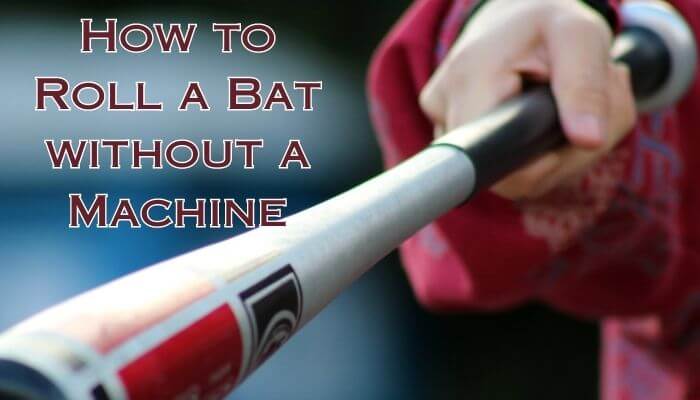Fans of baseball know that the quality of their bats can have a significant impact on the outcome of a game. It doesn’t matter if you’re a seasoned pro or just getting started; you deserve the most excellent performance possible from your bat.
So, how do you increase the performance of your bat without breaking the law? A popular method for improving the performance and longevity of a baseball or softball bat is rolling the bat.
The process could be automated, and machinery for doing so already exists, but not everyone can access them.
Don’t worry! In this post, I’ll explain how to hand-roll a bat using common materials and straightforward instructions. Get ready to breathe fresh life into your trusted machine!
Tools Needed for Rolling a Bat without a Machine
Let’s review the supplies you’ll need to roll a bat by hand before we start. Fortunately, you won’t need anything particularly elaborate or pricey.
A towel or cloth to lay down as protection for the table or countertop and the bat is all required.
The bat is used by pressing down with the hands and rolling it back and forth. So long!
Additional tools can be used to improve the process or to keep track of your rolled bats, but they are not required to begin rolling.

Step-by-Step Guide for Rolling a Bat by Hand
Let’s get started on rolling a bat by hand now that we have everything we need:
Step – 1 Use a hard surface like a table or countertop and cover it with a towel or cloth to avoid damaging either the surface or the bat.
Step – 2 Using one hand to hold the bat steady, the other can apply pressure on the rolling area. To avoid hurting the bat, you should start out slowly and carefully.
Step – 3 Be patient and gently rock the bat back and forth on the floor. We recommend doing this a few times.
Step – 4 Change the bat’s direction and keep doing the same thing.
Step – 5 You should keep going until you’ve rolled the whole bat.
There may be a need for further bat compression after rolling for optimal performance. To do this, you should put the bat in a bat bag or some other secure spot for a few hours or overnight while it is wrapped in a towel or cloth.
Tips for Rolling a Bat Without a Machine
Here are some additional tips to keep in mind while rolling a bat by hand:
- To prevent damage to the bat and the floor, always roll on a towel or cloth.
- Use light pressure at first, and build it up as you roll the bat.
- Roll the bat in a variety of directions to achieve uniform compression throughout the barrel.
- Take proper care to protect the bat from harm.
Pros and Cons of Rolling a Bat Without a Machine
Rolling a baseball bat without a machine has pros and cons.
The best part is you don’t need a machine to roll your bat. Instead, you can do that with your hand. Therefore, you don’t need to pay any penny. That is the best part. Moreover, rolling increases the hitting ability of your bat.
However, there are certain disadvantages also. One drawback is that it can take a while, especially if you’re rolling several bats at once.
Compression and uniformity may not be attained to the same degree as using a machine.
Last but not least, hand-rolling a bat can be strenuous on the body and could even cause harm if done incorrectly.
Troubleshooting Common Problems with Rolling Bats Without Machines
Breaking in a new or used bat can be done quickly and easily by rolling it by hand instead of using a machine. However, there are certain typical issues that may arise as you roll the bat by hand.
Uneven compression on the barrel is a common problem. Over time, this might develop cracks or dead patches on your bat. Applying pressure unevenly over the length of the barrel when rolling will cause this issue.
Another problem that may arise is that your bat is not being compressed enough. You may not be applying enough pressure or working for long enough periods of time if you are not feeling any resistance during rolling.
Try increasing both factors gradually until you start feeling more resistance.
If you notice any cracking sounds during the process, stop immediately, as this means something isn’t right with either your technique or the equipment used in hand-rolling bats.
After several passes through each part of your bat and it still doesn’t feel like it’s broken in, then perhaps consider moving up in grit sandpaper instead of giving up on hand-rolling altogether!
Tips for Maintaining a Rolled Bat
First of all, don’t take it out to the field straight after rolling. Wait at least 24 hours.
Second, use a protected grip or tape. Extra padding and defense against regular usage wear and tear are ensured.
Third, while you’re not using your rolled bat, keep it in a cool, dry place. Avoid putting it in direct sunlight or heating/cooling it too quickly.
Additionally, always inspect your rolled bat before each game or practice session. Look for any signs of cracks or damage that may have occurred during play.
If you want to maintain maximum performance from your rolled bat over an extended period of time, then make sure you get it re-rolled periodically by either hand-rolling or machine-rolling experts who know how to roll bats professionally.
By following these simple maintenance tips, you’ll be able to enjoy optimal performance from your rolled bats season after season!
Alternatives to Hand Rolling Bats
Even though hand-rolling a bat can help it perform better, there are other options you could look into.
The use of a bat roller machine is one such way that can improve productivity and yield reliable outcomes. Keep in mind that this equipment can be rather pricey and may need a certain level of expertise to operate safely and effectively.
You can make a bat-rolling machine yourself. Here is how you can do that How To Make A Bat Rolling Machine?
Another option is to use grit sandpaper to roughen the barrel’s outside. Batting performance (grip, speed) will be enhanced. However, grit sandpaper can also scratch the barrel if not used properly.
Another option is purchasing pre-rolled bats from reputable companies. These bats have already been rolled using professional equipment and techniques, saving you time and effort while still providing high-quality results.
In addition, you can also opt for buying composite or aluminum bats with thinner walls, as they tend to perform better right out of the wrapper without needing additional rolling.
Frequently Asked Questions
How long does it take to roll a bat by hand?
It depends on the individual. Generally, it can take from 30 minutes to some hours.
Can any bat be rolled by hand?
Not all bats are suitable for rolling by hand. Bats that are made of composite materials are the most effective for rolling, while aluminum and wood bats may not benefit as much from the process.
Can rolling a bat without a machine damage the bat?
Yes, it can if you don’t do the rolling properly. It’s important to use even pressure and avoid over-rolling the bat, which can cause it to become too compressed and less effective.
How often should a rolled bat be rotated?
It’s recommended to rotate a rolled bat after every 50-100 swings to prevent uneven wear and tear and maintain its performance.
Are rolled bats legal for use in all leagues and organizations?
Generally speaking, bat rolling is not forbidden. It is a break-in process that is legal by most league authorities. But shaving is illegal, and never use bat shaving techniques. Here is another blog on this Bat Rolling And Shaving – Can You Do It Or Not?
Final Words
Hand rolling a bat is a cheap and easy way to get more out of a baseball or softball bat. Time-consuming and strenuous, it can help you build the muscle and technique you need to become a more powerful striker.
You may roll your own bat without resorting to pricey equipment or services if you follow the methods explained in this article and steer clear of typical pitfalls.
If you want more consistent results, you should look into other methods and remember to take care of your bat after rolling it.

Hello everyone. My name is Jason Butler, and I live in California, America. I was a professional AAA Minor League Baseball player. I lost my chance of playing MLB for injury issues, but I did not lose my love for baseball. I attended the coaching training program and am now working as a coach in a small school in San Diego.
I always love to share my experience and knowledge if that can help you. Play baseball, and stay fit.
